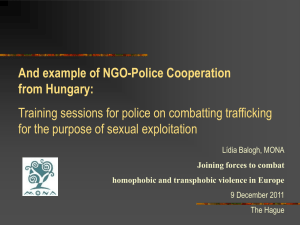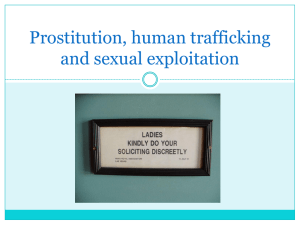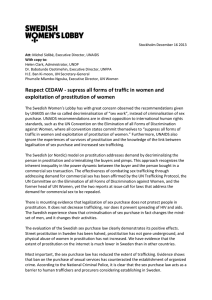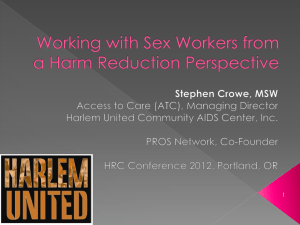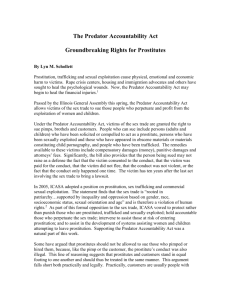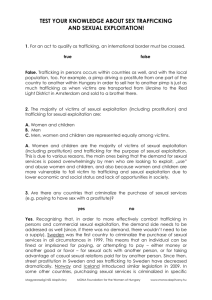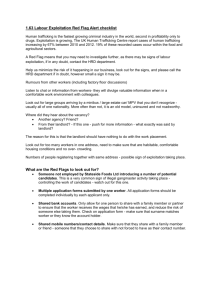Combating prostitution and trafficking for sexual exploitation within
advertisement
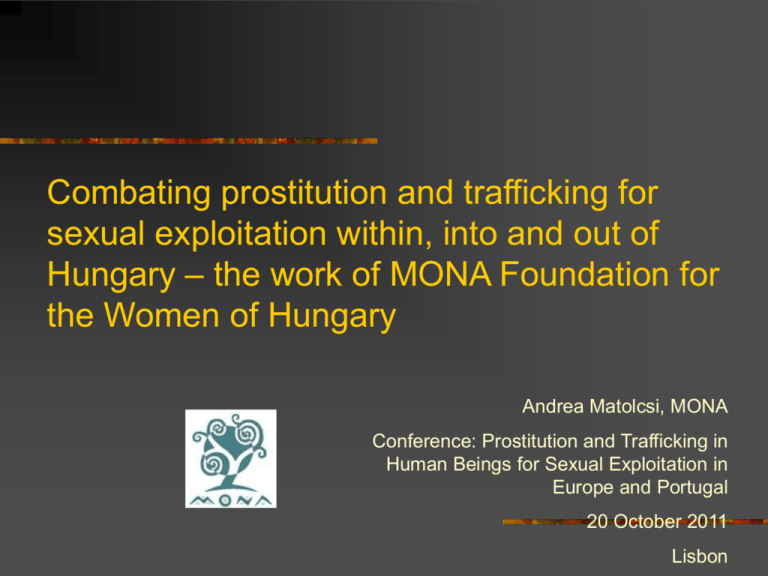
Combating prostitution and trafficking for sexual exploitation within, into and out of Hungary – the work of MONA Foundation for the Women of Hungary Andrea Matolcsi, MONA Conference: Prostitution and Trafficking in Human Beings for Sexual Exploitation in Europe and Portugal 20 October 2011 Lisbon MONA Foundation for the Women of Hungary Non-partisan gender equality NGO founded in 1992 Topics: women‘s participation in public life and the labor market, women in the media, gender-based violence (including prostitution and trafficking for sexual exploitation) Activities: research and publications, advocacy, conferences, professional fora, awareness raising and trainings for professionals National and international networks (e.g. Hungarian Women‘s Lobby – European Women‘s Lobby), national state-NGO consultative mechanisms. Hungary: trends Internal trafficking (street, private homes, brothels) Trafficking out of Hungary: largest foreign nationality and approx. 25-30% among prostitutes Amsterdam's red light district, 98-99% of street prostitutes in Zürich. Also Italy, Germany, Spain, Ireland, Greece, Canada, US, Mexico. Especially vulnerable: the socioeconomically disadvantaged, Roma, minors in, or adults coming out of state care institutions) Trafficking into Hungary: not many cases known of, but have been cases of women from Ukraine and Romania, boys from Romania. Hungary: legislation, victim assistance, prosecution Despite high scale of sexual exploitation and trafficking, inadequate legislation, protection of victims, investigation and prosecution. Legislation: lack of connection between trafficking and prostitution; Trafficking hard to prove, so few cases registered as such, most as prostitutionrelated crimes regulation criminalizing purchase of sex from minors, but separate from prostitution and trafficking laws, not known/used by authorities; prostitution a ‗crime against sexual morals‘, i.e. no human victim = no assistance to persons in prostitution who are victims of prostitution-related crimes. Victim assistance: currently one shelter for whole country (10 million) for victims of trafficking (also women trying to escape internal prostitution), 3 rooms. Long hiatuses without any shelter at all. Government funding for it sporadic, no public tender process. Prevention: one government demand-reduction campaign in 2009, efficacy and reach questionable. However: recently, government attention to the issue of trafficking and their efforts in the field seem to be improving. 2006-2007 study „Implementing gender equality principles to combat trafficking and to prevent sexual exploitation of women and children‖ The political, public administration and police leaders interviewed: Did not have knowledge about the connection between prostitution and human trafficking, the phenomena‘s social background and causes, the sociological characteristics of the actors involved, the local (Hungarian) and international situations, or of practices in other countries; Were not clear about the fact that, until the age of 18, someone is a child, even as concerns prostitution (answers: a girl is an adult, and can therefore begin prostitution, once menstruation begins); 2006-2007 study (cont‘d) Were not very familiar with the relevant national legislation and barely knew anything about international instruments, agreements and conventions; Had a double standard: the (female) prostitute, due to economic reasons or necessity, lack of morals or bad role models, CHOOSES prostitution, while the (male) sex-buyer, due to illness, inability to form relationships, uncontrollable extreme bodily urges or loneliness, is FORCED to use prostitution; Did not think to consider that the support of and assistance to prostitutes or victims wishing to get out of prostitution is a state task and responsibility; Regarding services to be offered, brought up solely health checks, which (wrongly) serve to protect the sex-buyers (while there was no mention of, for example, rehabilitation, accommodation, perhaps rescue, therapy, or exit assistance for getting out of conditions of prostitution and trafficking). ‗Development of Inter disciplinary Cooperation in Hungary to Combat Prostitution and Trafficking for the Purpose of Sexual Exploitation and to Support Victims‘ (2008-2010) Supported by EEA/Norwegian Financial Mechanism Main activities/‘outputs‘: Research, Professional forums organized for and with the target groups for the purpose of developing interdisciplinary cooperation, Proposals for the modification and development of national legislation as regards human trafficking, prostitution and victim assistance, Proposals for the foundations of the structural organization, main tasks and operational principles and guidelines of a future nation-wide network of victim assistance and shelters; The development and implementation of pilot trainings for members of the Hungarian police forces Trainings for professionals Pilot trainings for police within framework of 2008-2010 project Sensitization, knowledge and capacity building 3 x 2 days of trainings (two at the Budapest Police Headquarters and one for police officers under the Veszprém County Police Headquarters), 35 participants, Set of training materials developed for police regarding human trafficking and sexual exploitation Trainings for professionals II Results: positive change in attitude among participants, improved knowledge of background of prostitution and trafficking, increased empathy towards victims. Feedback from participants: ―Beneath the seemingly superficial issue of prostitution lie deeper and more dense roots than I had imagined.‖ ―It is important to understand the psychological background of victims, and to approach them during the police interview in such a way that they are then able to cooperate.‖ ―This information should be provided to as many police units as possible.‖ ―Cooperating with NGOs is indispensable and necessary.‖ ―Thank you for these two days; they contained information that truly revived hope in me.‖ Trainings for professionals III Expanded and implemented for other professionals, e.g. social workers (child care and child protection services, working with street prostitution), teachers, judges. 4 mixedgroup trainings in Jan – March 2011 with similarly positive feedback, more planned for Nov-Dec 2011. 2010 and 2011 conferences 2010: „Legal and institutional conditions for combating prostitution and trafficking for the purpose of sexual exploitation— Hungarian and international experiences‖ 2011: „Prostitution and trafficking for the purpose of sexual exploitation: International and Hungarian experiences, challenges and opportunities for action‖ Awareness Raising • Sziget Festival • Flash Mob – October 18, 2011 •Media Lobbying, advocacy, monitoring, cooperation EWL ‗Together for a Europe Free from Prostitution Campaign‘: meetings in Brussels with 2 MEPs, June 2011 press conference/launch of Hungarian video clip Child prostitution petition – 1,000 signatures Assisting US Embassy in Budapest with preparation of annual TIP report Consultation and cooperation with National AntiTrafficking Coordinator Police-child protection services-NGO working group Magyarországi Női Alapítvány www.mona-hungary.hu mona.alapitvany@gmail.com
